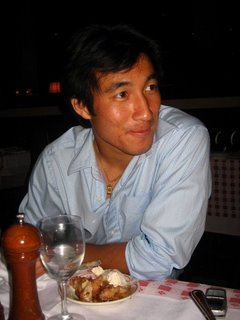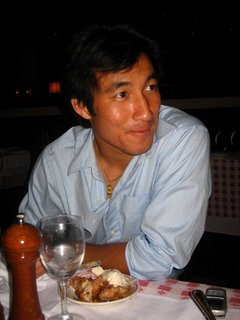More on tone, fingerstroke technique etc. here:
http://members.aol.com/chang8828/contents.htmWhat is "Good Tone"?
The Basic Keystroke, Pianissimo
The basic keystroke must be learned by every pianist. Without it, nothing else will make a meaningful difference – you can’t build a Taj Mahal out of mud-bricks and straw. The keystroke consists of 3 main components, the downstroke, the hold, and the lift. This might sound like a trivially simple thing to learn, but it is not, and most piano teachers struggle to teach their students the correct keystroke. The difficulties arise mostly because the mechanics of the keystroke have not been adequately explained anywhere; therefore, those explanations will be the major topics of these paragraphs.
The downstroke is what creates the piano sound initially; in the correct motion, it must be as quick as possible, yet with control of the volume. This control is not easy because we found out in the gravity drop section that faster downstroke generally means louder sound. The quickness gives the note its precise timing; without this quickness, the timing of the note start becomes a sloppy affair. Therefore, whether the music is slow or fast, the downstroke must be basically fast. These requirements of fast stroke, control of volume, and many others we will shortly encounter, bring us to a most important principle of learning piano – finger sensitivity. The finger must be able to sense and execute many requirements before you can master the basic keystroke. In order to control volume, the downstroke should consist of 2 parts; an initial strong component to break the friction/inertia of the key and start its motion, and a second component with the appropriate strength for the desired volume. The suggestion to “play deeply into the keys” is a good one in the sense that the downstroke must not slow down; it must accelerate as you reach the bottom so that you never lose control over the hammer.
This 2-part motion is especially important when playing pianissimo. In a well regulated concert grand, friction is nearly zero and the inertia of the system is low. In all other pianos (which comprises 99% of all pianos) there is friction that must be overcome, especially when you first start the downstroke (friction is highest when the motion is zero), and there are numerous imbalances in the system that produce inertia. Assuming that the piano is properly voiced, you can play very soft pianissimo by first breaking the friction/inertia and then making the soft stroke. These 2 components must join seamlessly so that to an onlooker, it looks like a single motion, with the flesh of the fingers acting like shock absorbers. The required fast downstroke means that the finger muscle must have a high proportion of fast muscles (see section 7.a below). This is achieved by fast motion practice over extended periods of time (about a year) and avoiding strength exercises; therefore, the statement that piano technique requires finger strength is absolutely wrong. We need to cultivate finger speed and sensitivity.
The hold component of the keystroke is necessary to hold the hammer using the backcheck and to accurately control the note duration. Without the hold, the hammer can flop around, producing extraneous sounds, cause problems with repeated notes, trills, etc. Beginners will have difficulty with making a smooth transition between the downstroke and hold. Do not push down on the key during the hold in an attempt to “push deeply into the piano”; gravity is sufficient to hold the key down. The length of the hold is what controls color and expression; therefore it is an important part of the music.
The lift causes the damper to fall onto the strings and terminate the sound. Together with the hold, it determines the note duration. Just as with the downstroke, the lift must be fast in order to control the note duration accurately. Therefore, the pianist must make a conscious effort to grow fast muscles in both the extensor muscles, just as we did with the flexor muscles for the downstroke. Especially when playing fast, many students will forget about the lift entirely, resulting in sloppy play. A run may end up consisting of staccato, legato, and overlapping notes. Fast parallel sets may end up sounding as if they were being played with some pedal.
By controlling all 3 components of the basic key stroke accurately, you maintain complete control over the piano; specifically, over the hammer and the damper, and this control is needed for authoritative play. These components determine the nature of each note. In normal play, there is a small gap between the lift and the next downstroke, but this gap should not be noticeable. In legato, there is no gap, and there should be no significant overlap. You can now see why a fast downstroke and equally fast lift is so important, even during slow play. In staccato (section c) and fast play (7.i), we need to modify all these components, and they will be discussed separately. If you had never practiced these components before, start practice with all 5 fingers, C to G, as you do when playing a scale and apply the components to each finger, HS. If you want to exercise the extensor muscles, you can exaggerate the quick lift stroke. Try to keep all the non-playing fingers on the keys lightly. As you try to speed up the down and lift strokes, playing about one note per second, you may start to build stress, and so you need to practice until you can eliminate the stress. The most important thing to remember about the hold component is that you must instantly relax during the hold after the quick downstroke. In other words, you need to practice both stroke speed and relaxation speed. Then gradually speed up the play; however, there is no need to play fast at this time. Just get up to some comfortable speed. Now do the same with any slow music you can play, such as the 1st movement of Beethoven’s Moonlight, HS. If you had never done this before, HT will be initially very awkward because you now need to coordinate so many components in both hands. However, as you practice, the music will come out better, you will gain much more control over the expression, and you should get the feeling that you can now play much more musically. There should be no more missed or wrong notes, all the notes should be more even, and you can execute all the expression marks with greater effect. The performances will be much more consistent from day to day, and technique will progress more predictably. Without a good basic keystroke, you can get into trouble when you play different pianos, or pianos that are not in good regulation, and the music can often come out worse as you practice more because you can acquire bad habits such as inaccurate timing. Of course, the whole process described in this one paragraph may take weeks or even months to complete.
















